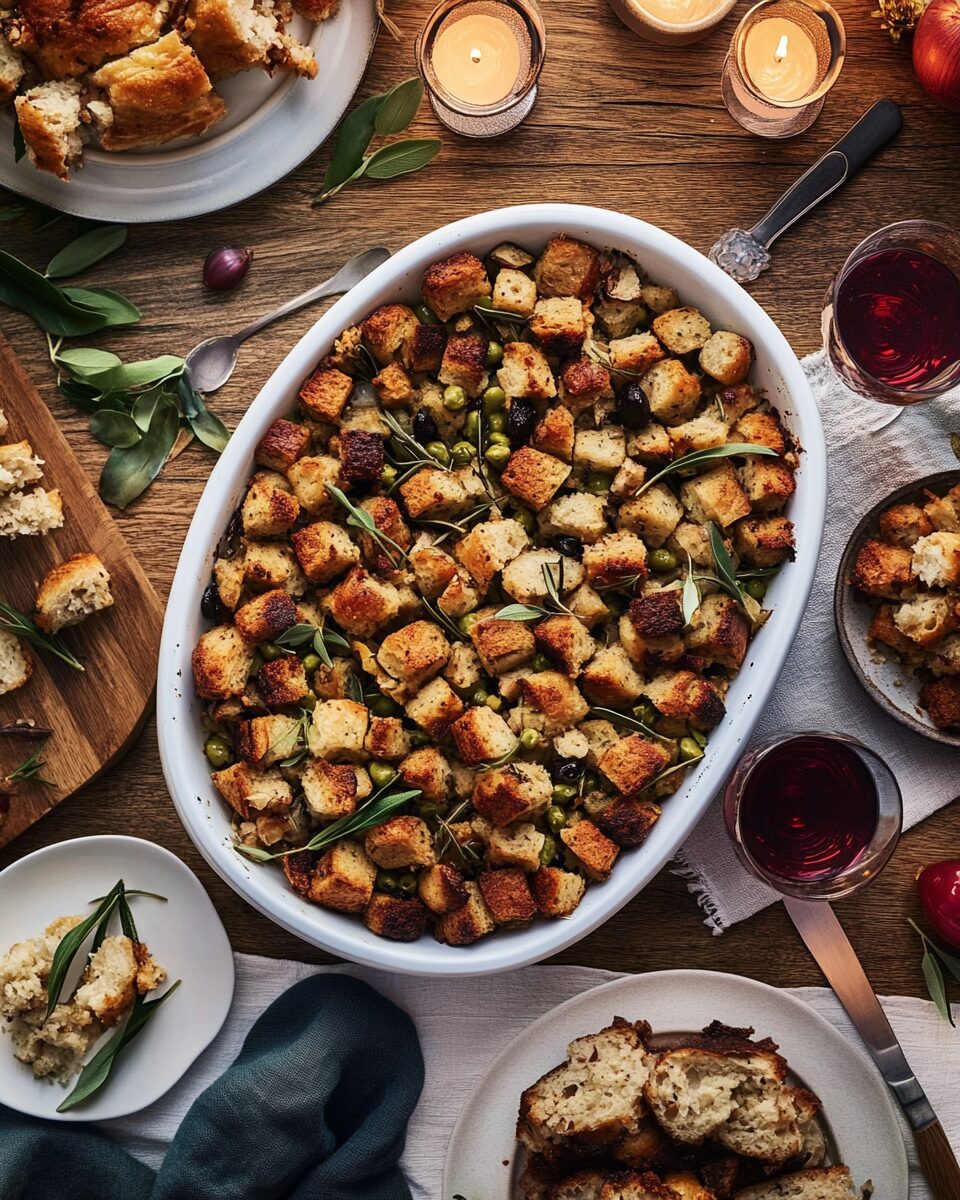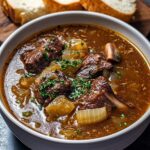The comforting aroma of freshly baked stuffing, with butter-infused breadcrumbs and hints of herbs, creates the ultimate side dish for any holiday meal. This Moist and Savory Stuffing combines simplicity with classic flavors, making it an ideal complement to roasted turkey and other festive dishes.
Easy to prepare and packed with flavor, this stuffing brings together fresh vegetables, savory broth, and seasoned bread for a dish that pleases every palate. Whether you prefer a soft texture or a crispy topping, this recipe adapts to your preferences, making it a versatile addition to any holiday menu.
Full Recipe:
- 1/2 cup butter
- 1 cup celery, chopped
- 1 cup onion, chopped
- 4 cups Swanson® Chicken Broth
- 14 ounces (1 bag) seasoned stuffing mix
Directions:
- Preheat oven to 350°F (175°C).
- In a 3-quart saucepan, melt butter over medium heat. Add chopped celery and onion, cooking until tender, approximately 5 minutes, stirring occasionally.
- Pour in chicken broth and bring to a boil, then remove from heat.
- Stir the seasoned stuffing mix into the broth mixture until combined and lightly moist.
- Spoon the stuffing mixture into a greased 9x13x2-inch baking dish and cover.
- Bake in the preheated oven for 30 minutes or until hot.
Prep Time: 10 minutes | Cooking Time: 30 minutes | Total Time: 40 minutes
Kcal: 250 kcal per serving | Servings: 8
A Culinary Classic: The Origins and Significance of Stuffing
Stuffing, in various forms, has been a beloved side dish across cultures for centuries, with records dating back to Ancient Rome, where it was used to fill roasted fowl and other meats. The core concept has remained simple: bread combined with aromatics, herbs, and seasonings to complement roasted meats, particularly poultry. In American cuisine, stuffing has come to symbolize Thanksgiving and holiday gatherings, a dish that adds warmth, flavor, and texture to the holiday meal.
American stuffing, especially, evolved with influences from European settlers who incorporated local ingredients like cornmeal, sage, and other herbs native to North America. Over time, the dish transformed to include a variety of ingredients, catering to regional preferences and the availability of ingredients, from sausage-stuffed variants in the South to the use of apples and dried fruits in the Northeast. This flexibility in ingredients and seasonings is what makes stuffing such an adaptable recipe and a timeless classic.
Why Moist and Savory Stuffing Stands Out
The Moist and Savory Stuffing recipe is celebrated for its balance between rich flavors and satisfying texture. Achieving a stuffing that is neither too dry nor too mushy is a fine art. This recipe accomplishes that balance by using butter and chicken broth to moisten the bread cubes without oversaturating them, resulting in a stuffing that’s firm enough to hold its shape yet soft and flavorful with every bite.
What makes this recipe particularly attractive is its accessibility. It doesn’t rely on hard-to-find ingredients; instead, it utilizes kitchen staples like celery, onions, butter, and bread. This simplicity makes it easy to prepare, yet the inclusion of aromatics like sage and thyme, combined with the hearty richness of broth, gives it a depth of flavor that enhances any holiday table.
Seasonal Relevance and the Role of Stuffing in Holiday Gatherings
Stuffing is a seasonal favorite, not only because it pairs so well with turkey but also because it brings a sense of comfort and tradition. For many, the aroma of onions, celery, and sage cooking on the stove signifies that the holiday season is in full swing. The dish’s warm and filling nature embodies the spirit of fall and winter gatherings, providing a hearty accompaniment to roasted meats and complementing other sides like mashed potatoes, cranberry sauce, and roasted vegetables.
Because of its strong association with Thanksgiving and Christmas in the United States, stuffing is more than just a side dish. It’s a dish that represents nostalgia and celebration, evoking memories of family, friends, and shared meals. Many families have their own variations, adding unique touches like sausage, apples, nuts, or even oysters, making it a versatile dish that adapts to family traditions.
Customizing the Moist and Savory Stuffing Recipe for Various Tastes and Diets
One of the beauties of stuffing is that it can easily be customized. Here are several ways to adapt this recipe for different tastes and dietary needs:
1. Adding Protein and Texture
- Sausage: Adding crumbled sausage provides a meaty richness that complements the buttery, herb-infused bread.
- Bacon: Bacon adds a smoky, savory dimension that pairs beautifully with the traditional flavors.
- Nuts: Adding chopped nuts, such as pecans or walnuts, introduces crunch and enhances the stuffing’s texture, adding a layer of complexity.
2. Incorporating Fruits for Sweetness
- Cranberries: Adding dried cranberries gives a subtle sweetness and tartness, offering a lovely contrast to the savory components.
- Apples or Pears: Freshly chopped apples or pears add a crisp, juicy texture and a hint of sweetness, balancing the savory flavors of the onions and herbs.
3. Vegetarian and Vegan Options
- Vegetable Broth: For a vegetarian version, swap chicken broth with vegetable broth to keep the stuffing savory and flavorful.
- Vegan Butter or Olive Oil: Substitute the butter with vegan alternatives like olive oil or plant-based butter to make the recipe vegan-friendly.
4. Gluten-Free and Grain-Free Options
- Gluten-Free Bread: Using a gluten-free bread allows those with gluten sensitivities to enjoy this classic dish.
- Cauliflower Base: For a low-carb, grain-free option, some people substitute cauliflower florets for bread. The cauliflower can be seasoned and roasted to provide a similar texture and flavor profile.
Tips for Perfect Stuffing Texture and Flavor
Achieving the perfect stuffing involves a few essential techniques. Here are tips for maximizing the flavor and consistency:
1. Choosing the Right Bread
- Use a sturdy bread that can absorb the broth and retain its shape. Day-old or slightly stale bread is ideal as it will soak up the broth without becoming overly mushy. Rustic bread, sourdough, or French bread work especially well for this purpose.
2. Balancing Moisture
- Moisture levels in stuffing are crucial. If the stuffing appears too dry, add a bit more broth, as it will continue to absorb moisture as it bakes. On the other hand, avoid soaking the bread completely, as this can result in a mushy texture.
3. Herbs and Seasonings
- The herbs you use define the stuffing’s flavor profile. Sage, thyme, and rosemary are traditional choices that pair well with holiday meals. Fresh herbs work wonderfully, but dried herbs can also be used if fresh is unavailable.
4. Adjusting the Texture
- For those who enjoy a slightly crunchy stuffing, bake it uncovered for the final few minutes. This will create a golden-brown, slightly crispy top layer, adding an enjoyable contrast to the soft interior.
Variations and Regional Influences on Traditional Stuffing
Stuffing recipes vary widely depending on regional preferences and family traditions. In the Southern United States, cornbread is often used as the base, yielding a unique flavor and texture. Other regions might include shellfish, such as oysters, or make use of wild rice as a base. These regional variations highlight the versatility of stuffing and its adaptability to local ingredients.
Additionally, the Moist and Savory Stuffing recipe can be easily adapted to incorporate regional flavors. For a New England twist, add chunks of apple and pecans. To give it a Southern flair, add crumbled cornbread and andouille sausage. These adaptations show how a classic dish like stuffing can be reimagined to suit different tastes and traditions.
Conclusion: Why the Moist and Savory Stuffing Recipe Deserves a Spot on Your Holiday Table
Stuffing isn’t merely a side dish; it’s a quintessential part of holiday meals that brings warmth, tradition, and flavor to the table. The Moist and Savory Stuffing recipe combines simplicity with depth, delivering a dish that’s both comforting and adaptable. Its rich, savory taste is balanced by the subtle sweetness of sautéed onions and the aromatic depth of herbs, creating a harmonious dish that complements a variety of main courses, particularly roasted poultry.
This recipe’s versatility is one of its greatest assets. It serves as a blank canvas that can be customized to fit any dietary preference or taste, whether you’re looking for a gluten-free option, a vegan-friendly recipe, or a protein-packed variation. No matter how you adjust it, the core elements of the recipe—bread, broth, butter, and herbs—deliver the comforting flavors that make stuffing a beloved holiday tradition.
In essence, the Moist and Savory Stuffing recipe is a celebration of seasonal flavors and family togetherness. Its aroma and taste evoke nostalgia, reminding us of gatherings with loved ones and the joy of shared meals. Whether you’re an experienced cook or a first-time host, this stuffing recipe offers an easy yet satisfying way to enhance your holiday menu and create cherished memories around the dinner table.





